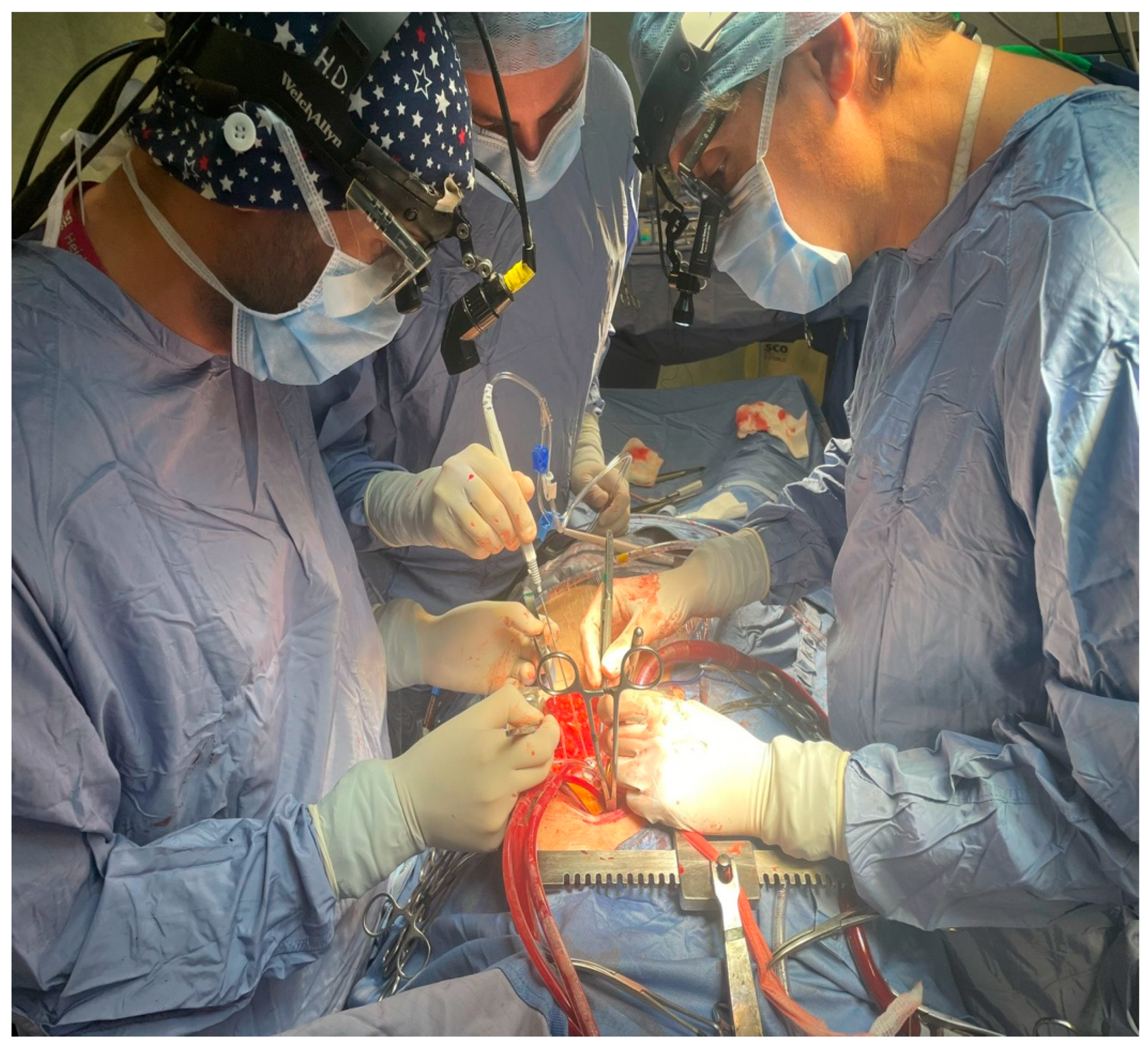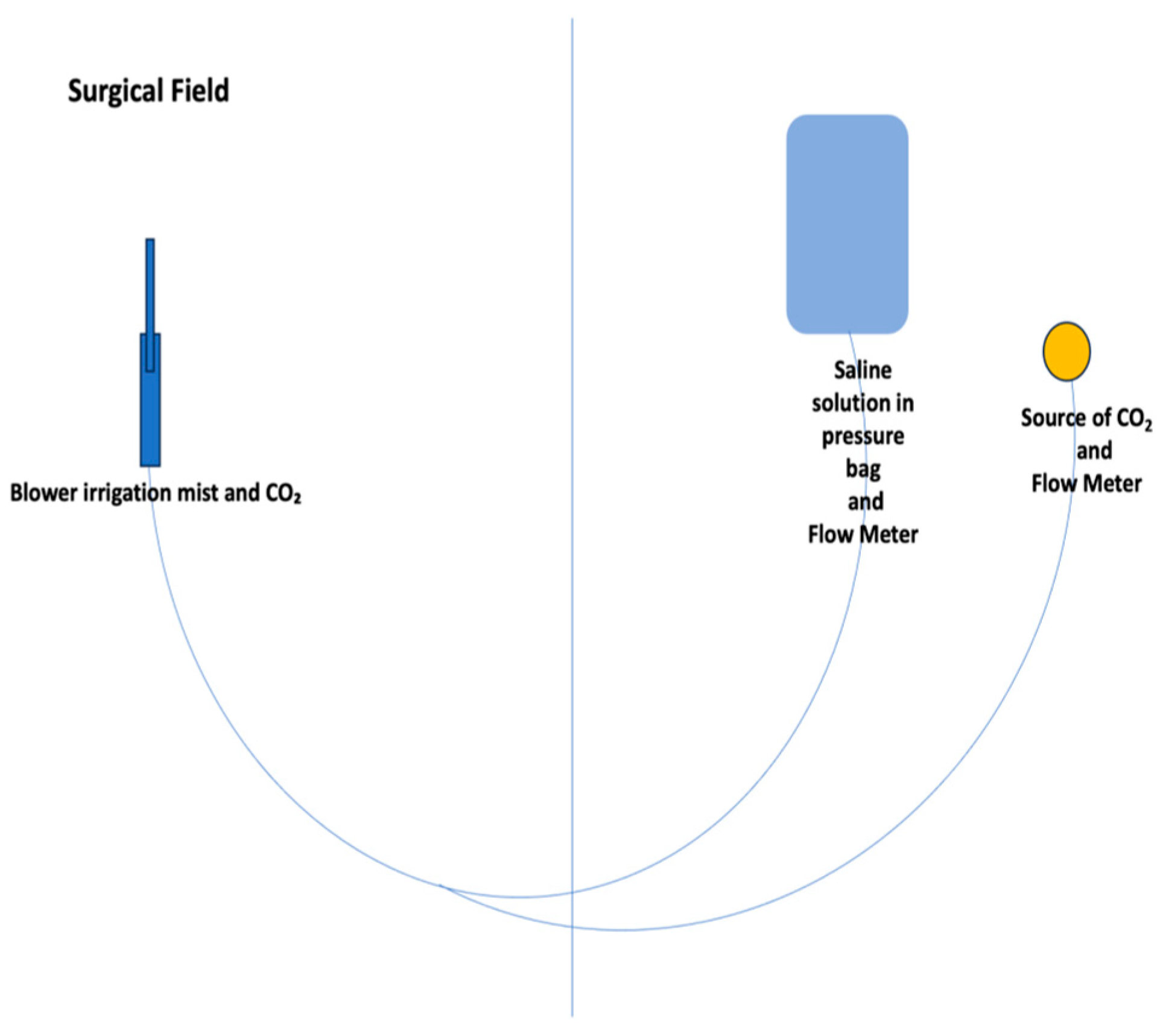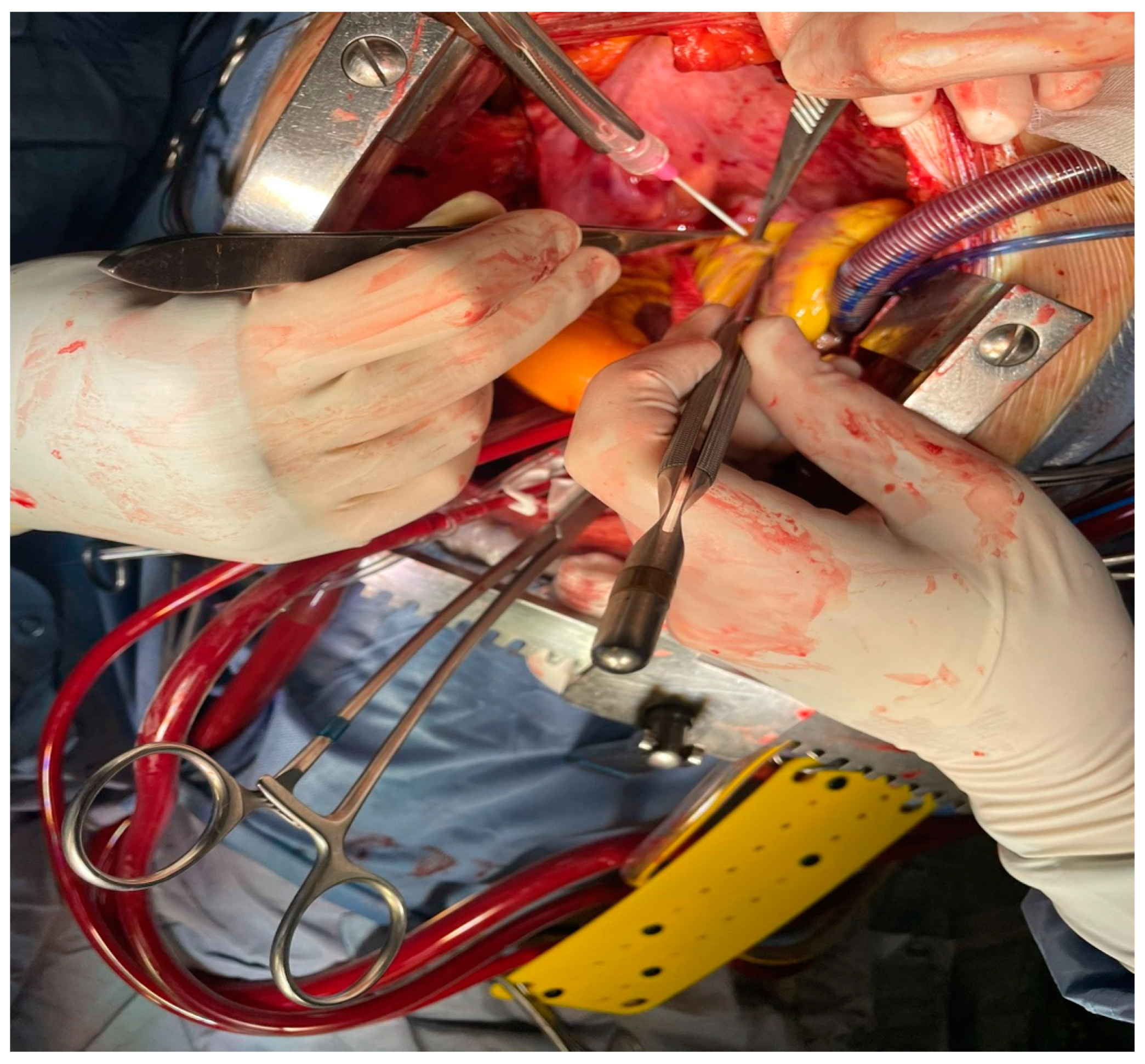Comparative Analysis of Irrigation Mist and CO2 vs. Direct CO2 Blower in On-Pump Coronary Artery Bypass Grafting Anastomosis: Efficacy, Efficiency, and Fibrillation upon De-Clamping and Micro-Embolic Gas Activity Incidence
Abstract
:1. Introduction
2. Materials and Methods
- Group 1 (n = 20): patients operated on during a period before the introduction of the irrigation mist and CO2, where direct CO2 blowers were used;
- Group 2 (n = 20): patients operated on after the ClearView™ Blower/Mister system became available and was routinely used during surgery.
- Group 1 (Direct CO2 Blower): Patients in this group underwent CABG using a traditional direct CO2 blower to clear blood from the surgical field. No irrigation mist was applied, and the CO2 blower was operated continuously during critical stages of the procedure, including the anastomosis phase;
- Group 2 (Irrigation Mist and CO2): patients in this group received CABG using the irrigation mist and CO2, which combines a CO2 blower with a fine irrigation mist to improve visualization and maintain tissue hydration during surgery.
- Visualization Quality: assessed subjectively by the operating surgeon, rated on a scale from 1 (poor) to 5 (excellent), and recorded in operative notes;
- Incidence of Fibrillation During Aortic Declamping: the number of patients experiencing fibrillation immediately after aortic cross-clamp removal was documented;
- Microembolic Gas Activity: transesophageal echocardiography (TEE) was used intraoperatively to detect the presence of microembolic gas bubbles in the cardiac chambers during and after aortic declamping.
3. Results
Patient and Surgical Characteristics
- Proximal Anastomoses: the average number of proximal anastomoses was 2.3 ± 0.6 in Group 1 (direct CO2 blower) and 2.4 ± 0.5 in Group 2 (the irrigation mist and CO2);
- Distal Anastomoses: the average number of distal anastomoses was 3.1 ± 0.8 in Group 1 and 3.2 ± 0.7 in Group 2;
- Grafting Techniques: use of the Y-mammary graft was 40% in Group 1 and 50% in Group 2, while sequential grafting with the mammary artery and saphenous vein was performed in 60% of Group 1 and 50% of Group 2 patients.
4. Discussion
5. Conclusions
Author Contributions
Funding
Institutional Review Board Statement
Informed Consent Statement
Data Availability Statement
Conflicts of Interest
References
- Lee, C.S.; Yoon, Y.S.; Shim, J.K.; Lim, H.K. Successful resuscitation of cardiac arrest caused by CO2 embolism with intra-aortic injection of epinephrine during off-pump coronary bypass surgery—A case report. Korean J. Anesthesiol. 2013, 65, 562–564. [Google Scholar] [CrossRef] [PubMed]
- Angelini, G.D.; Reeves, B.C.; Culliford, L.A.; Maishman, R.; Rogers, C.A.; Anastasiadis, K.; Antonitsis, P.; Argiriadou, H.; Carrel, T.; Keller, D.; et al. Conventional versus minimally invasive extracorporeal circulation in patients undergoing cardiac surgery: A randomized controlled trial (COMICS). Perfusion 2024. [Google Scholar] [CrossRef] [PubMed]
- Plass, C.A.; Podesser, B.K.; Prusa, A.M. Effect of blower-mister devices on vasoreactivity of coronary artery bypass grafts. J. Thorac. Cardiovasc. Surg. 2010, 140, 923–927. [Google Scholar] [CrossRef] [PubMed]
- Wippermann, J.; Albes, J.M.; Liebing, K.; Breuer, M.; Kaluza, M.; Strauch, J.; Wahlers, T. Simple on-site assembled blower-mister device provides sufficient humidification and visualization in off-pump surgery. Ann. Thorac. Surg. 2006, 82, 1134–1136. [Google Scholar] [CrossRef] [PubMed]
- Shim, J.K.; Choi, Y.S.; Yoo, K.J.; Kwak, Y.L. Carbon dioxide embolism induced right coronary artery ischemia during off-pump obtuse marginalis artery grafting. Eur. J. Cardiothorac. Surg. 2009, 36, 598–599. [Google Scholar] [CrossRef] [PubMed]
- Badreldin, A.M.; Albert, A.A.; Ismail, M.M.; Heldwein, M.; Doerr, F.; Bossert, T.; Lichtenberg, A.; Hekmat, K. Gaseous emboli during off-pump surgery with T-graft technique, two different mechanisms. Interact. Cardiovasc. Thorac. Surg. 2010, 10, 766–769. [Google Scholar] [CrossRef] [PubMed]
- Jin, R.; Hiratzka, L.F.; Grunkemeier, G.L.; Krause, A.; Page, U.S., III. Aborted off-pump coronary artery bypass patients have much worse outcomes than on-pump or successful off-pump patients. Circulation 2005, 112 (Suppl. 9), I337. [Google Scholar] [CrossRef] [PubMed]
- Dai, J.; Liu, M.; Liu, X.; Li, J.; Jin, K.; Chen, L.; Bao, M.; Jiang, G. Carbon Dioxide Blower Facilitates Visceral Pleurectomy in Malignant Pleural Mesothelioma. Ann. Thorac. Surg. 2022, 114, e71–e74. [Google Scholar] [CrossRef] [PubMed]
- Suma, H.; Isomura, T.; Horii, T.; SatWo, T. Intraoperative coronary artery imaging with infrared camera in off-pump CABG. Ann. Thorac. Surg. 2000, 70, 1741–1742. [Google Scholar] [CrossRef] [PubMed]
- Repossini, A.; Baudo, M.; D’Alonzo, M.; Petruccelli, R.; Rosati, F. MIDCAB Tips and tricks for a successful procedure. Multimed. Man. Cardiothorac. Surg. 2020, 2020. [Google Scholar] [CrossRef]





| Characteristic | Group 1 (Direct CO2 Blower) | Group 2 (Irrigation Mist and CO2) | p-Value |
|---|---|---|---|
| Number of Patients | 20 | 20 | - |
| Age (years) | 65 ± 8 | 66 ± 9 | 0.65 |
| Male Gender (%) | 80% | 85% | 0.72 |
| Body Weight (kg) | 78 ± 10 | 77 ± 9 | 0.82 |
| Height (cm) | 170 ± 8 | 169 ± 9 | 0.78 |
| Body Surface Area (BSA) (m2) | 1.90 ± 0.15 | 1.88 ± 0.16 | 0.75 |
| Diabetes (%) | 40% | 35% | 0.78 |
| Hypertension (%) | 60% | 65% | 0.85 |
| Hyperlipidemia (%) | 55% | 50% | 0.80 |
| Left Ventricular Ejection Fraction (LVEF %) | 55% ± 7% | 56% ± 6% | 0.68 |
| Perioperative and Postoperative Outcomes | Group 1 (Direct CO2 Blower) | Group 2 (Irrigation Mist and CO2) | p-Value |
|---|---|---|---|
| Proximal Anastomoses (mean ± SD) | 2.3 ± 0.6 | 2.4 ± 0.5 | 0.69 |
| Distal Anastomoses (mean ± SD) | 3.1 ± 0.8 | 3.2 ± 0.7 | 0.75 |
| Y-Mammary Graft (%) | 40% | 50% | 0.58 |
| Sequential Graft (Mammary + Vein) (%) | 60% | 50% | 0.65 |
| Visualization Quality (Score) | 3.8 ± 0.6 | 4.7 ± 0.5 | <0.01 |
| Incidence of Ventricular Fibrillation During Declamping (%) | 8 patients (40%) | 2 patients (10%) | 0.03 |
| Micro-Embolic Gas Activity (%) | 10 patients (50%) | 3 patients (15%) | 0.02 |
| Cardiopulmonary Bypass (CPB) Time (min) | 85 | 77 | 0.05 |
| Cross-Clamp Time (min) | 67 | 65 | 0.72 |
| Troponin Levels at 24 Hours (ng/L) | 0.12 ± 0.03 | 0.11 ± 0.04 | >0.05 |
| Major Postoperative Complications (%) | None | None | - |
| Length of Postoperative Hospital Stay (days) | 7.5 ± 1.2 | 7.0 ± 1.1 | 0.32 |
Disclaimer/Publisher’s Note: The statements, opinions and data contained in all publications are solely those of the individual author(s) and contributor(s) and not of MDPI and/or the editor(s). MDPI and/or the editor(s) disclaim responsibility for any injury to people or property resulting from any ideas, methods, instructions or products referred to in the content. |
© 2024 by the authors. Published by MDPI on behalf of the Lithuanian University of Health Sciences. Licensee MDPI, Basel, Switzerland. This article is an open access article distributed under the terms and conditions of the Creative Commons Attribution (CC BY) license (https://creativecommons.org/licenses/by/4.0/).
Share and Cite
Condello, I.; Speziale, G.; Fiore, F.; Nasso, G. Comparative Analysis of Irrigation Mist and CO2 vs. Direct CO2 Blower in On-Pump Coronary Artery Bypass Grafting Anastomosis: Efficacy, Efficiency, and Fibrillation upon De-Clamping and Micro-Embolic Gas Activity Incidence. Medicina 2024, 60, 2035. https://doi.org/10.3390/medicina60122035
Condello I, Speziale G, Fiore F, Nasso G. Comparative Analysis of Irrigation Mist and CO2 vs. Direct CO2 Blower in On-Pump Coronary Artery Bypass Grafting Anastomosis: Efficacy, Efficiency, and Fibrillation upon De-Clamping and Micro-Embolic Gas Activity Incidence. Medicina. 2024; 60(12):2035. https://doi.org/10.3390/medicina60122035
Chicago/Turabian StyleCondello, Ignazio, Giuseppe Speziale, Flavio Fiore, and Giuseppe Nasso. 2024. "Comparative Analysis of Irrigation Mist and CO2 vs. Direct CO2 Blower in On-Pump Coronary Artery Bypass Grafting Anastomosis: Efficacy, Efficiency, and Fibrillation upon De-Clamping and Micro-Embolic Gas Activity Incidence" Medicina 60, no. 12: 2035. https://doi.org/10.3390/medicina60122035
APA StyleCondello, I., Speziale, G., Fiore, F., & Nasso, G. (2024). Comparative Analysis of Irrigation Mist and CO2 vs. Direct CO2 Blower in On-Pump Coronary Artery Bypass Grafting Anastomosis: Efficacy, Efficiency, and Fibrillation upon De-Clamping and Micro-Embolic Gas Activity Incidence. Medicina, 60(12), 2035. https://doi.org/10.3390/medicina60122035








